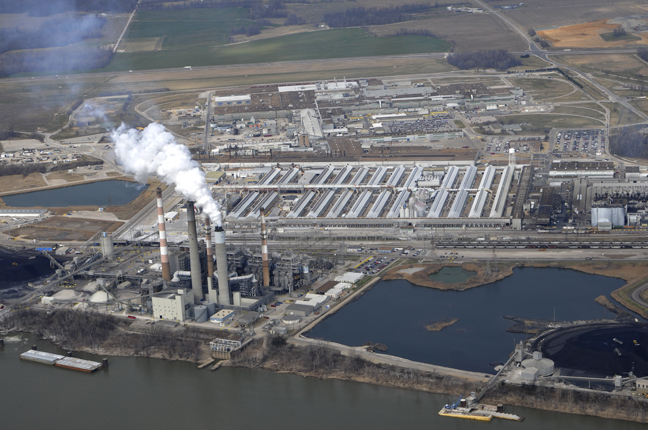600 Employees facing termination
January 7, 2016 – by John Blair, valleywatch.net editor

Alcoa’s sprawling 900 + sure facility in Warrick County, just east of Newburgh has been the largest aluminum smelter in the nation for several years as others have been forced to close due to economic issues with the price of aluminum. Now, like the others, a substantial portion of the Warrick plant will shut down in 2016. © 2016 BlairPhotoEVV
 Alcoa, the largest primary aluminum producer in the nation announced today that it is permanently shutting down smelter operation at its Warrick facility which was the largest smelter left operating in the United States. In their announcement, they also said that about 600 employees would lose their jobs.
Alcoa, the largest primary aluminum producer in the nation announced today that it is permanently shutting down smelter operation at its Warrick facility which was the largest smelter left operating in the United States. In their announcement, they also said that about 600 employees would lose their jobs.
Alcoa has operated the smelter since 1960 and employs just under 2,000 people in total at the Warrick County facility located just east of Newburgh, IN.
Alcoa claims their decision was based strictly on market issues which have forced the price of aluminum to historic lows due to international competition.
Alcoa did say that their power plants and rolling mills will remain open and it is only the smelter part of the business that will be shuttered permanently.
Their claim that they will keep open their power plants is curious since the primary need for the electric power is smelting. If the smelters are closed, and they keep the power plants operating, it can be assumed that they will operate their power plants as so called “merchants” selling their power on the open market. But that market is not good these days as renewable energy and natural gas have caused the retirement of numerous coal fired power plants across the country,
It should be noted that the power plants operate mainly to supply energy for the smelting process and with that shutting down the demand for power will diminish considerably. Currently, the power plants that carry a nameplate capacity of 800 megawatts in total do not sell power on the open market.
However, the Warrick Unit 4 is “jointly owned with Vectren with each owning 135 MW. At this time, it is unclear how all the power will be divided although Vectren has no plans to give up their portion. If Alcoa’s part of Warrick 4 is sufficient to operate the remaining operations at the plant, then it could well be that Units 1, 2 and 3 will be permanently shuttered. This is especially so since there are a number of environmental issues those 1960’s plants must contend with, including Carbon Dioxide as it pertain to climate change.
If those three plants are forced to closed due to lack of demand for their output, the region’s air quality will likely improve substantially. For one thing, Alcoa power plants have consistently emitted more than five million pounds each year of toxic chemicals, mostly to the air as Hydrogen Chloride and Hydrogen Fluoride gas. Under this scenario, about two thirds of Alcoa’s emissions, both toxic and non toxic will cease to exist.
Also in question at this time is the fate of a huge level of toxic coal ash that is stored on site in ponds and landfills which must be cleaned upended new rules published in 2015 by USEPA.
Another issue is what will happen to the coal mines that Alcoa owns. With a reduced demand for coal, the fate of those mines might also be in question, even if it was decided to sell the coal to others instead of just Alcoa.
